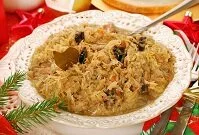Dining Etiquette
 Bigos
Bigos
Many Poles will meticulously prepare a meal for a guest, while a smaller number may get lost in the time and be well behind schedule. Either way, you should arrive on time and be dressed quite conservatively. Once inside be sure to offer your assistance with food preparation; most hosts won't need this help and will insist you relax, while a minority of hosts may truly need your help. Either way, the offer will be very much appreciated.
As the food is served, let your host take the lead as dinner may begin simply by eating, a prayer, or a toast. You should try everything you're served as turning down food may make your host feel like he or she must make a new dish for you. Poles eat in the continental style (knife in the right hand, fork in the left), although few locals will demand this from their guests.
Most hosts will push more food on you, so if possible, begin with just a little food so you have room to eat more later. On some occasions a meal will be interrupted regularly with toasts and drinking vodka. The host will give the first toast and if you feel like giving one later in the meal all are welcome to join in.
In business meetings, the inviter is expected to pay for the entire meal, although it is expected that you offer to assist with the bill.
When eating at a sit down restaurant, tipping about 5-10% of the bill is appropriate and if rounding up meets this amount you'll fit right in with the locals. In tourist centers, particularly in Warsaw's Old Town, tipping should increase to about 10%, however here waiters and waitresses tend to speak great English and service tends to be impeccable.
Drinks
Poland has its share of non-alcoholic drinks, but few are original and none make headlines. All popular international drinks are available in the country, including tea, coffee, juices, soft drinks, and milk.
However, when it comes to vodkas the country is quite original; in fact the first historical reference to vodka comes from Poland and many agree that vodka was founded in Poland by the ancestors of today's Poles. Although vodka distilled from rye is their national drink, every local shop offers dozens of varieties, including sweet honey vodkas and hot burning chili vodkas to the most popular and common rye vodkas, including famous exports like Chopin and Belvedere. While most liquor stores have a huge selection of local and international vodkas, all popular alcoholic beverages are available, including beers, wines, and other hard liquors.
There is no consensus on the cleanliness of the tap water in Poland. After an upgrade to their water treatment facilities recently the tap water is generally safe to drink, but locals still refuse to drink it. In the cities and mountains the water is safest, although it is most likely safe everywhere. Of course you may stay on the side of caution and avoid the tap water entirely. If you do decide to drink the tap water, remember that many people may have troubles adjusting to the local water, as it will most certainly be different from what your system is used to.